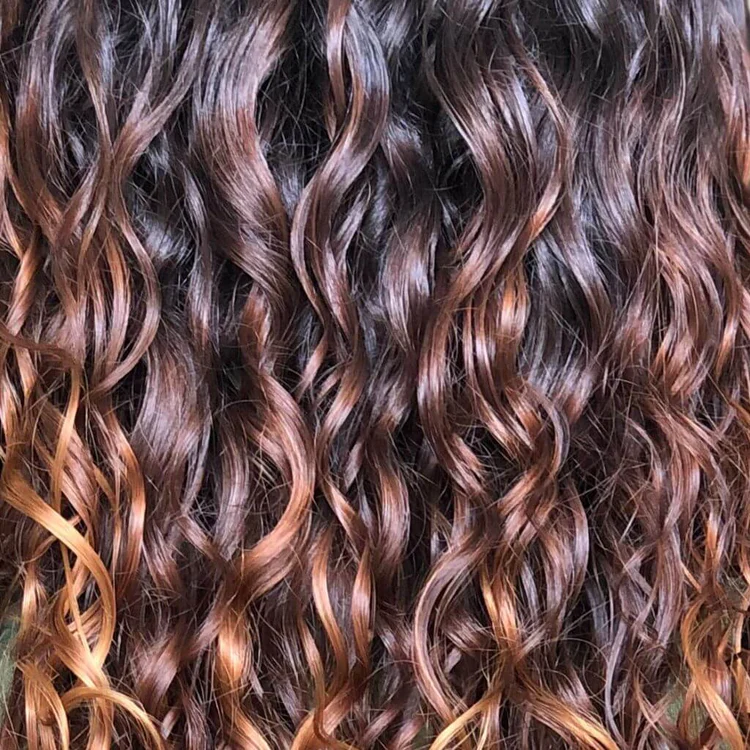From loose waves to tight coils, curly hair comes in many forms – and understanding your specific curl type is key to keeping your hair healthy and vibrant. In this curly hair guide, we’ll explain the different curl types and how to care for each one. Let’s dive into it.

Type 2: Wavy Hair
Type 2 hair is wavy. It falls between straight and curly hair, and forms a natural S-pattern, with the degree of wave varying across its subcategories :
- 2A: Fine, barely-there waves
- 2B: Thicker, more defined waves with a slight frizz
- 2C: Coarser, deeper waves with the beginnings of a curl pattern



How to care for type 2 hair
- Avoid daily shampooing: Overwashing strips your waves of their natural oils, which can lead to dryness.
- Keep your hair well moisturised: Using a lightweight curl-defining conditioner helps keep frizz and tangles at bay without weighing down the hair.
- Detangle with your fingers: Using a brush on wavy hair can cause frizz, lead to breakage, and reduce texture – so use your fingers or a wide-tooth comb instead. Oh, and make sure not to detangle your wavy hair while dry, as this will destroy that beautiful S-pattern.
- Use a diffuser attachment when blow-drying: It’s the easiest way to add extra bounce and volume to your waves. Don’t forget to apply heat protectant, though, to keep damage at a minimum.
- Try plopping: Wrap a large cotton t-shirt or microfibre towel around your hair and leave it to dry for 30 minutes to an hour. This prevents gravity from pulling your waves down and friction from disturbing them, resulting in the voluminous waves of your dreams.

Type 3: Curly Hair
Type 3 curls form more distinct ringlets that range from loose spirals to tight corkscrews. This hair type can be prone to dryness and requires more moisture – but more on that shortly. Similar to wavy hair, curly hair also comes in three subcategories:
- 3A: Large, loose spirals with some wavy strands
- 3B: Tighter, springy ringlets with medium volume and bounce
- 3C: Tight corkscrews with lots of volume



How to care for type 3 hair
- Moisturise generously: We mentioned before that type 3 hair needs regular hydration, so adding leave-in conditioner and curl cream to your routine can be a good idea.
- Avoid overwashing: Just like with type 2 hair, over-shampooing curly hair will strip it of its natural oils. Keep it to once or twice a week, and wash with cold water and a sulphate-free shampoo like Software’s Hair Growth Shampoo.
- Ditch the heat tools: Heat is curly hair’s worst enemy, so heat style sparingly in order to prevent damage, breakage, and split ends.
- Use a silk pillowcase: Silk is a smooth, non-absorbent material that allows your hair to glide with less friction than cotton and, as a result, causes a lot less damage.
- Consider co-washing: This means using only conditioner and no shampoo. It doesn’t work for everyone but if your curls are particularly dry, it’s worth giving it a go.

Type 4: Coily Hair
Last but not least, type 4 hair consists of tight coils that are densely packed and can range from fine to coarse. This is the driest hair type, so proper hydration is paramount, and it can fall into three subtypes:
- 4A: Soft, dense coils in an S-shaped pattern
- 4B: Zig-zagging curls that are densely packed and less defined
- 4C: Very tight, very dense zig-zag curls with lots of volume



How to care for type 4 hair
- Use deep moisturisers: Incorporate deep conditioning treatments regularly to maintain moisture.
- Use protective styles: From box braids to bantu knots, faux locs and more, protective hairstyles protect type 4 hair by maintaining moisture, preventing tangling and breakage, and shielding the coils against environmental aggressors.
- Use the LCO method: Start your hair care routine with liquid (or leave-in conditioner), followed by a cream, and then an oil. This order is usually recommended for low-porosity hair and fine or medium coils.
- Or the LOC method: If you have high porosity and thin hair, the LOC method may be more appropriate. Starts with water-based products, then oil, and finally cream.
From soft waves to tight coils, each kind of curly hair has its unique beauty and needs. Understanding your curl type (and subtype) means you can choose the right products and create the best routine to keep your locks looking fabulous, day in and day out.
Read more of our Beauty articles below.





